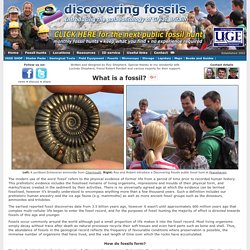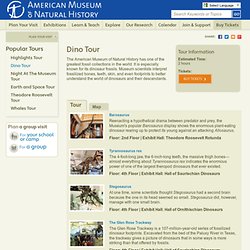

Now_and_Then. When you first find a fossil it is sometimes hard to tell what kind of animal it belonged to.

It is usually just a part of the original animal. In this section you will find pictures of various fossils that you too may some day discover. Grades 3-5. Paleontology. LEARNING ABOUT FOSSILS. Finding Fossils In this activity students will learn how fossils are formed and where they are found.

PLO: Students will draw a picture of a fossil underground using the paint program. Materials Needed: Computer with internet access Web sites: Microsoft paint program First, click here to read about how a fossil is formed. Then click here and do the activity. Next, click here to find out some places where you might find fossils.
Finally, using the paint program, draw a picture of a fossil underground. The product is the picture that the student creates. What is a fossil? How do fossils form? Left: A pyritised Echioceras ammonite from Charmouth.

Right: Roy and Robert introduce a Discovering Fossils public fossil hunt at Peacehaven. How do fossils form? Death Left: A fish returns to its birth place to spawn. Right: Having spawned the fish dies and shortly after sinks to the seafloor. Decay and burial Left: After several weeks the soft body tissues have mostly decayed. Sediment accumulation and permineralisation Left: Several months pass and all that remains of the buried fish is its skeleton.
Uplift and exposure Left: Over time the rock is distorted and uplifted by geological forces associated with continental movement, raising it above sea level. Dino Tour. The Arthur Ross Hall of Meteorites explores essential questions about the origins of our solar system some 4.6 billion years ago by examining meteorites, rocky fragments from space that reveal clues about the formation and evolution of the Sun and planets.

The David S. and Ruth L. Gottesman Hall of Planet Earth, the first part of the Rose Center to open in June 1999, displays an amazing collection of geological specimens, chosen specifically to show how our planet works. The Milstein Hall of Ocean Life highlights the drama of the undersea world and its diverse and complex web of life in a fully immersive marine environment. The hall is home to one of the Museum’s most celebrated displays—a 94-foot-long, 21,000-pound model of a blue whale suspended from the ceiling. The Anne and Bernard Spitzer Hall of Human Origins pairs fossils with DNA research to present the remarkable history of human evolution. The Felix M. Educationjourney: Science Pictures and a Multiplication Freebie. What a week!

I feel like this week has absolutely flown by, even though it has been jam packed full of fun activities! I have to say I'm quite excited for a long weekend! Earlier this week I did a weathering and erosion experiment using Skittles and an eye dropper. The water wore away the hard outer coating and then the colored exterior ran off to show erosion. It was so FUN and EASY! Then today I set up nine fossil stations for my students, and we had a blast! In one station, my students went on a Cookie "Fossil" Dig where they had to use toothpicks to dig for chocolate chips (fossils). Discovery Education. OLogy. Fireflies aren't flies at all.

They're beetles! Bats are the only mammals that can truly fly. Antarctica is a continent surrounded by ocean. The Arctic is the opposite, an expanse of ocean surrounded by continents. Half a million neurons form every minute during the first five months in the womb. STEM Education Resource Center.
Welcome to PBS Teachers STEM Education Resource Center!

Science, Technology, Engineering and Math (STEM) Resources for Grades PreK-12 PBS offers all Americans the opportunity to explore new ideas and new worlds related to science, technology, engineering, and mathematics (STEM) learning through television and online content. On-line broadband access and digital media are dramatically changing the opportunities available to the nation’s educators improving STEM education. Our recent national educator survey (Grunwald, 2009) indicates that more teachers than ever before are turning to digital media resources to help their students understand concepts, practice new skills and engage in exciting, authentic learning experiences. Explore some of our great STEM offerings for grades PreK-12.
Lawrence Hall of Science - 24/7 Science. How fast does the wind blow?

What makes things sticky? Where do insects live and plants grow? What is the best way to clean up the environment? How do humans measure up in the animal kingdom? So many questions—and so many ways to find answers! Bridge Builders. Discovery Education. Summary Students will examine and sketch various trace fossils from an unknown creature and then construct an image of the creature that they believe produced these fossils.

Overview Topic: FossilsReal World Science Topics: An exploration of how trace fossils are used by scientists An exploration of how scientists draw inferences from pieces of data Objective Students will gain an understanding of how scientists use trace fossils to construct a model of an unknown creature and infer information about the creature. Activity Difficulty Rating: 4 Each hands-on science activity has been ranked based on difficulty of set up and how difficult they are to perform.
Use these quick refreshers to prep for your next class. Fossil Coloring Pages,Free Fossil Activities for Kid, Fossil Pictures to Print. Fossil Evidence Third 3rd Grade Science Standards at I4C. Third grade science. DocsTeach. Library of Congress Home. Our Documents - Home. American Rhetoric: The Power of Oratory in the United States.
Time For Kids. The Stacks for Kids. Sports Illustrated Kids. America's Story from America's Library. Books for beginning readers of all ages. Capstone Digital.